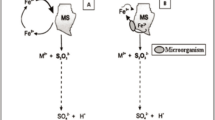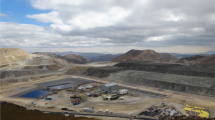Abstract
The quest for quality mineral resources has led to the development of many technologies that can be used to refine minerals. Biohydrometallurgy is becoming an increasingly acceptable technology worldwide because it is cheap and environmentally friendly. This technology has been successfully developed for some sulphidic minerals such as gold and copper. In spite of wide acceptability of this technology, there are limitations to its applications especially in the treatment of non-sulphidic minerals such as iron ore minerals. High levels of elements such as potassium (K) and phosphorus (P) in iron ore minerals are known to reduce the quality and price of these minerals. Hydrometallurgical methods that are non-biological involving the use of chemicals are usually used to deal with this problem. However, recent advances in mining technologies favour green technologies, known as biohydrometallurgy, with minimal impact on the environment. This technology can be divided into two, namely bioleaching and biobeneficiation. This review focuses on Biobeneficiation of iron ore minerals. Biobeneficiation of iron ore is very challenging due to the low price and chemical constitution of the ore. There are substantial interests in the exploration of this technology for improving the quality of iron ore minerals. In this review, current developments in the biobeneficiation of iron ore minerals are considered, and potential solutions to challenges faced in the wider adoption of this technology are proposed.


Similar content being viewed by others
Abbreviations
- Ln− :
-
Any organic ligand with oxidation number n, such as oxalate (Ln− = C2O4 2− or HC2O4 −), citrate (Ln−C6H5O7 3− or C6H6O7 2− or C6H7O7 −),
- >:
-
Particle surface
- >Fe′′′:
-
Trivalent lattice iron on the particle surface
- >F′′:
-
Bivalent lattice iron on the particle surface
- [>Fe–L]:
-
Surface complex
- …:
-
Adsorbed species on the particle surface
- II, III:
-
Oxidation number of surface lattice iron
- N+, n − :
-
Valence of aqueous species
References
Adeleke R, Cloete T, Bertrand A, Khasa D (2010) Mobilisation of potassium and phosphorus from iron ore by ectomycorrhizal fungi. W J Microbiol Biotechnol 26:1901–1913
Adeleke R, Cloete T, Bertrand A, Khasa D (2012) Iron ore weathering potentials of ectomycorrhizal plants. Mycorrhiza 1–10
Adeleke R, Cloete T, Khasa D (2010) Isolation and identification of iron ore-solubilising fungus. S Afr J Sci 106:1–6
Adeleke R, Cloete T, Khasa D (2012) Culturable microorganisms associated with Sishen iron ore and their potential roles in biobeneficiation. W J Microbiol Biotechnol 28:1057–1070
Astrup J, Hammerbeck EC (1998) Iron. In: Wilson MG, Anhaeusser CR (eds) The mineral resources of South Africa. Council for Geoscience, South Africa, pp 402–416
Banfield JF, Barker WW, Welch SA, Taunton A (1999) Biological impact on mineral dissolution: application of the lichen model to understanding mineral weathering in the rhizosphere. Proc Natl Acad Sci USA 96:3404–3411
Biswas AK (1981) Principles of blast furnace ironmaking. Cootha publishing house, Brisbane
Bodsworth C (1994) The extraction and refining of metals. CRC Press, Florida
Brierley JA, Brierley CL (2001) Present and future commercial applications of biohydrometallurgy. Hydrometallurgy 59:233–239
Buis P (1995). Bioremediation techniques for the removal of phosphorus from iron ore. Ph.D. Dissertation. Mining engineering. Michigan Technological University, USA, p 129
Cameselle C, Bohlmann JT, Nunez MJ, Lema JM (1998) Oxalic acid production by Aspergillus niger, Part I. Influence of sucrose and milk whey as carbon source. Bioprocess Eng 19:247–252
Cameselle C, Ricart MT, Nunez MJ, Lema JM (2003) Iron removal from kaolin. Comparison between ‘‘in situ’’ and ‘‘two stage’’ bioleaching processes. Hydrometallurgy 68:97–105
Cameselle C, Nunez MJ, Lema JM, Pais J (1995) Leaching of iron by a spent fermentation liquor: influence of temperature, pH, agitation and citric acid concentration. J Ind Microbiol 14:288–292
Cheng CY, Misra VN, Clough J, Muni R (1999) Dephosphorisation of western Australian iron ore by hydrometallurgical process. Miners Eng 12:1083–1092
Cloete TE, Oosthuizen DJ (2001) The role of extracellular exopolymers in the removal of phosphorus from activated sludge. Water Res 35:3595–3598
Dale LL (1984) The pace of mineral depletion in the United States. Land Econs 60:255–267
Davies J, Moon JT, Traice FB (1978) Alkalis in the blast furnace. Ironmak Steelmak 5:151–161
Delvasto P, Balleste, A, Muñoz JA, González F, Blázquez ML, García-Balboa C (2005). Exploring the possibilities of biological beneficiation of iron-ores: The phosphorus problem. In: Proceedings of the 15th steelmaking conference, 5th ironmaking conference and 1st environment and recycling symposium IAS (CD-ROM), San Nicolás, Buenos Aires, Argentina, Nov 7–10, 2005. pp 71–82
Delvasto P, Ballester A, Muñoz JA, González F, Blázquez ML, Igual JM, Valverde A, García-Balboa C (2009) Mobilization of phosphorus from iron ore by the bacterium Burkholderia caribensis FeGL03. Miners Eng 22(1):9
Delvasto P, Valverde A, Ballester A, Muñoz JA, González F, Blázquez ML, Igual JM, García-Balboa C (2008) Diversity and activity of phosphate bioleaching bacteria from a high-phosphorus iron ore. Hydrometallurgy 92:124–129
Eisele TC, Gabby KL (2014) Review of reductive leaching of iron by anaerobic bacteria. Min Process Extr Metall Rev Int J 35(2):75–105
Elkasabgy T (1984) Effect of alkalis on reduction behavior of acid iron ore pellets. Trans ISIJ 24:612–621
Franz A, Burgstaller W, Schinner F (1991) Leaching with Penicillium simplicissimum: influence of metals and buffers on proton extrusion and citric acid production. Appl Environ Microbiol 57:769–774
Goldstein AH, Braverman K, Osorio N (1999) Evidence for mutualism between a plant growing in a phosphate-limited desert environment and a mineral phosphate solubilizing (MPS) rhizobacterium. FEMS Microbiol Ecol 30:295–300
Groudev SN, Groudeva VI (1986) Biological leaching of aluminium from clays. Biotechnol Bioeng symp 16:91–99
Hoffmann MR, Arnold RG, Stephanopoulos G (1989) Microbial reduction of iron ore. United States patent 4880740
Hutchens E, Valsami-Jones E, McEldowney S, Gaze W, McLean J (2003) The role of heterotrophic bacteria in feldspar dissolution—an experimental approach. Mineral Mag 67:1157–1170
Jain N, Sharma D (2004) Biohydrometallurgy for nonsulfidic minerals—a review. Geomicrobiol J 21:135–144
Johnson DB, McGinness S (1991) Ferric iron reduction by acidophilic heterotrophic bacteria. Appl Environ Microbiol 57:207–211
Klein C, Barbara D (2002) The manual of mineral science. 23rd edn John wiley and sons, inc. Hoboken, New Jersey. USA pp 289–296
Klemic HJ, James HL, Eberlein GD (1973) In: Brobst DA, Pratt WP (eds) Washington. Iron Geol Surv, DC, pp 291–306
Konhauser K, Hamade T, Raiswell R, Morris RC, Ferris FG, Southam G, Canfield DE (2002) Could bacteria have formed the Precambrian banded iron formations? Geology 30:1079–1082
Kubicek CP, Kunar GS, Wohrer W, Rohr M (1988) Evidence for a cytoplasmatic pathway of oxalate biosynthesis in Aspergillus niger. Appl Environ Microbiol 54:633–637
Leake JR, Duran AL, Hardy KE, Johnson I, Beerling DJ, Banwart SA, Smits MM (2008) Biological weathering in soil: the role of symbiotic root-associated fungi biosensing minerals and directing photosynthate-energy into grain-scale mineral weathering. Miner Mag 72:85–89
Lin TF, Huang HI, Shen FT, Young CC (2006) The protons of gluconic acid are the major factor responsible for the dissolution of tricalcium phosphate by Burkholderia cepacia CC-A174 Bioresources Technology 97, pp 957–960
Marshall P (1984) Austenitic stainless steels microstructure and mechanical properties. Elsevier, New York
Modak JM, Vasan SS, Natarajan KA (2001) Calcium removal from bauxite using Paenibacillus polymyxa, In: Kawatra, SK, Natarajan, KA (eds) Minerals and metallurgical processing pp 6–12
Muhammed M, Zhang Y (1989) A hydrometallurgical process for the dephosphorization of iron ore. Hydrometallurgy 21:277–292
Olson GJ, Brierley JA, Brierley CL (2003) Bioleaching review part B. Appl Microbiol Biotechnol 63:249–257
Panias D, Taxiarchou M, Paspaliaris I, Kontopoulos A (1996) Mechanisms of dissolution of iron oxides in aqueous oxalic acid solutions. Hydrometallurgy 42:257–265
Parks EJ, Olson GJ, Brinckman FE, Baldi F (1990) Characterization by high performance liquid chromatography (HPLC) of the solubilization of phosphorus in iron ore by a fungus. J Ind Microbiol Biot 5:183–189
Pradhan D, Pal S, Sukla SB, Chaudhury GR, Das T (2008) Bioleaching of low-grade copper ores using indigenous microorganisms. Ind J Chem Technol 15:588–592
Ramachandran S, Fontanille P, Pandey A, Larroche C (2006) Gluconic acid: properties, applications and microbial production. Gluconic acid: a review. Food Technol Biotechnol 44(2):185–195
Rawlings D (2005) Characteristics and adaptability of iron- and sulfur-oxidizing microorganisms used for the recovery of metals from minerals and their concentrates. Microb Cell Fact 4:1–13
Rawlings DE (2002) Heavy metal mining using microbes. Annu Rev Microbiol 56:65–91
Rawlings DE, Dew D, du Plessis C (2003) Biomineralization of metal-containing ores and concentrates. Trends Biotechnol 21:38–44
Rezza I, Salinas E, Elorza M, Sanz de Tosetti M, Donati E (2001) Mechanisms involved in bioleaching of an aluminosilicate by heterotrophic microorganisms. Process Biochem 36:495–500
Rodriguez H, Fraga R (1999) Phosphate solubilizing bacteria and their role in plant growth promotion. Biotechnol Adv 17:319–339
Rosling A, Lindahl BD, Finlay RD (2004) Carbon allocation to ectomycorrhizal roots and mycelium colonising different mineral substrates. New Phytol 162:795–802
Sarvamangala H, Natarajan KA, Girisha ST (2012) Biobeneficiation of iron ores. Int J Min Eng Miner Process 1(2):21–30
Sashidhar B, Podile AR (2010) Mineral phosphate solubilization by rhizosphere bacteria and scope for manipulation of the direct oxidation pathway involving glucose dehydrogenase. J Appl Microbiol 109:1–12
Schippers A, Sand W (1999) Bacterial leaching of metal sulfides proceeds by two indirect mechanisms via thiosulfate or via polysulfides and sulfur. Appl Environ Microbiol 65:319–321
Sheng XF, Zhao F, He LY, Qiu G, Chen L (2008) Isolation and characterization of silicate mineral-solubilizing Bacillus globisporus Q12 from the surfaces of weathered feldspar. Can J Microbiol 54(1065):1064–1068
Sukhotin AM, Khentov AI (1980) Anodic behavior of iron oxides and repassivation of iron in acid solutions. Elektrokhimiya 16(7):1037–1041
Van Schöll L, Hoffland E, van Breemen N (2006) Organic anion exudation by ectomycorrhizal fungi and Pinus sylvestris in response to nutrient deficiencies. New Phytol 170:153–163
Vasan SS, Modak JM, Natarajan KA (2001) Some recent advances in the bioprocessing of bauxite. Int J Miner Process 62:173–18639
Welch SA, Barker WW, Banfield JF (1999) Microbial extracellular polysaccharides and plagioclase dissolution—effects of pH, CO2, and organic acids. Geochim Cosmochim Ac 63:1415–1419(1415)
White AF, Brantley SL (1995) Chemical weathering rates of silicate minerals: an overview. Rev Miner Geochem 31:1–22
Willey J, Sherwood L, Woolverton C (2007) Prescott’s Microbiology. McGraw-Hill Higher Education, Berkshire SL6 2QL, pp 703–706
Williams PJ (2008) The use of Aspergillus Niger for the removal of potassium and phosphorous from the iron ore of the Sishen iron ore mine, South Africa. University of Pretoria, Pretoria, pp 573–578
Yusfin Y, Chernousov P, Garten V, Karpov Y, Petelin A (1999) The role of alkalis and conserving resources in blast-furnace smelting. Metallurgist 43:54–58
Zegeye A, Yahaya S, Fialips CI, White M, Manning DA, Gray N (2008) Application of bacterial iron reduction for the removal of iron impurities from industrial silica sand and kaolin. American Geophysical Union, Fall Meeting
Author information
Authors and Affiliations
Corresponding author
Rights and permissions
About this article
Cite this article
Adeleke, R.A. Getting rid of the unwanted: highlights of developments and challenges of biobeneficiation of iron ore minerals—a review. J Ind Microbiol Biotechnol 41, 1731–1741 (2014). https://doi.org/10.1007/s10295-014-1514-4
Received:
Accepted:
Published:
Issue Date:
DOI: https://doi.org/10.1007/s10295-014-1514-4




